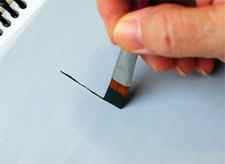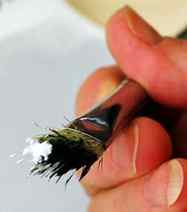This is where you override what should happen when you are adding Foliage meshes to the level.
HOW TO PAINT TREES
“Can you teach me how to paint trees?” That’s a question I am asked a lot. The simple answer is, “Yes, of course I can!”. And since I love to teach, I created this page to do just that for you.

Learn to paint these trees.
As you will learn on this page, there are many ways of painting a tree. Different brushes and techniques help in creating different kinds of trees. And the style in which you paint will also influence how that tree will look when you’re finished.
Well now, that brings me to brushes. Ever wondered what brushes to use when painting trees? I have provided resources at the end of this tutorial to help you select the right brushes to paint trees.
Of course using a line drawing to help lay out your tree design is always very useful and makes the learning experience even more enjoyable. So I have included a free guide which includes a line drawing. You’ll find it at the end of this tutorial as well.
I’ll teach you how to paint 4 different trees right on this page. I have step-by-step tutorials for you below. All you have to do is read on. You’ll be painting trees in no time.
Are you ready?
Let’s Get Started

You can learn this free hand technique
Let’s start with a simple evergreen tree using a Flat brush. All of the information you need about the correct brushes and sizes is provided at the end of this tutorial.

Load a Flat brush with green paint. Blend it on your palette and then use the chisel of the brush to create the trunk. Clean the brush and blot it.

Sideload your brush and blend it on your palette. Place the corner of the brush down at the tip to create the top of the tree. Now drop the clean side of the brush down and apply the paint horizontally from side to side. Re-load the brush with paint as needed. Need help in understanding how to sideload? It’s all in the Tree Painting Guide I provide at the end of this tutorial.
Here is the progression of steps as your tree comes to life.

This is a very simple technique that delivers great results. I know you can learn how to do this.


It’s time to apply finishing touches to suggest snow. I lay out all of the details in my Free Guide on How To Paint Trees.
Simple Evergreen Using an Angle Bristle Brush

Time for a change and a new lesson. Let’s learn how to paint trees with the Angle Bristle Brush, also known as a Foliage Brush. This brush creates wonderful texture when used in an up and down pouncing motion. We refer to this pouncing motion as “stippling”. You’ll find more info on this brush at the end of this tutorial.

Let’s start by drawing a pyramid shape with a straight line down the middle. The line in the middle represents the trunk of the tree.

Your first step is to put the brush in water to plump up the bristles of the brush. A 10 minute soak will do the trick. Blot it well.
Now load the brush with dark green paint, pounce the bristles on your palette until you see there’s nice texture.

From the base of the tree.

To the very tip. this tree is ready for snow.

And here are the finishing touches that bring it all together. Using my step by step guide, I know you can do this. It’s all explained in detail in the Guide, as you’ll see at the end of this tutorial.

How to paint trees: Step 1 – Dark masses
When you paint the mass of the foliage, start by painting a large dark mass. Make sure you get the proportions correct and pay particular attention to the top contour. This generally will suggest a specific species if you get this correct.

How to paint trees: step 2 – Skyholes
One of the characteristics of a tree are the holes in it through which you can see the sky. These are called ‘sky holes’. If you use a fan brush you can gently touch the canvas with the sky color to suggest these holes.

How to paint trees: step 3 – Creative brushwork
Get creative with your brushstrokes. Twirl the brush. Use the front and side of the brush. Push the brush in to the canvas with different levels of pressure. Experiment with you own techniques.

Members of the Apprentice Program can see the full video this month of a tree painted using these and many other brushwork techniques.
For a complete description and lesson on painting trees, see painting lesson N02 Tree Masses, in the Apprentice Program Year Four.
LOD
Static Mesh LOD is supported on foliage. There are a few caveats:
- You should ensure your Static Mesh has only one entry in the Elements array (visible under LOD0).
- Note that light and shadow maps are shared between all LOD levels, so all LODs need to use the same unwrapping.
- Currently, the entire cluster of instances change LODs simultaneously. We may add support for distance-based fading per instance in the future.
Lighting
Each individual mesh instance has its own shadow and/or light map generated by Lightmass, and these are tiled together for each precomputed batch. There are several settings on the Static Mesh that should be checked for precomputed lighting to operate well with instanced foliage. Lightmass is less forgiving when generating shadow maps for instanced meshes, and incorrect settings could lead to black meshes after rebuilding lighting.
- Light Map Coordinate Index – This must be set to a valid UV channel that has a unique UV unwrapping. The Static Mesh Editor’s Generate Unique UVs feature, which you can access from the Window menu, can quickly generate a unique unwrapping.
- Lightmap Resolution – This must be a small enough number so that all the shadow maps for instances in a single cluster (by default 100) can be tiled together without exceeding the maximum texture resolution (4094×4096).
Foliage Scalability
Foliage Static Meshes can use the Scalability System to increase or decrease the amount of Foliage Instances that are currently being rendered on screen. To add this functionality to your project you will need to do the following:
-
Right-click in the Content Browser. Under the Create Advanced Asset section, expand the Foliage section and select the Static Mesh Foliage option.





